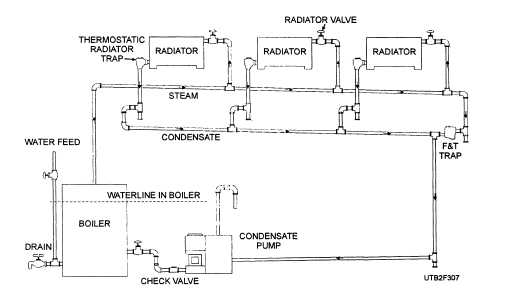inoperative check valves. The return traps and the check valves should be cleaned and inspected; and, if necessary, the defective parts or the whole unit should be replaced.
TWO-PIPE VAPOR SYSTEM WITH A CONDENSATE PUMP
The two-pipe vapor system with a condensate pump, as shown in figure 3-7, is similar to the two-pipe vapor system with the return trap, except that the condensate is returned to the boiler by a power-driven centrifugal pump, instead of by a return trap. This system includes a separate main, a radiator feed at the top, and a return system with thermostatically trapped outlets located at the bottom of the radiators opposite to the feed end. The return main terminates at the receiver of the condensate pump, where all of the air in the system is discharged to a vent on the receiver. With the use of a condensate pump, all of the returns to the pump are kept dry and the radiators can be located below the boiler waterline. This is not possible with the steam distribution systems previously described. The radiators should be installed above the return main to permit gravity flow of the condensate from the radiator, and the return main should pitch downward to the pump receiver.
Installation
Two-pipe vapor systems with condensate pumps are basically alike in design. However, since two installations are seldom alike, it is necessary to install each system according to the mechanical blueprints furnished by the civil engineer and the instructions of the manufacturer of the equipment.
Operation
The two-pipe vapor steam distribution system can be operated at the pressure limit of the steam plant boiler, provided the condensate pump is designed for sufficient discharge head necessary to overcome discharge pipe friction loss, boiler pressure, and the hydrostatic head between the pump outlet and the waterline of the boiler. The ends of the steam mains are drained and vented into the dry return main through a combination float and thermostatic trap.
The two-pipe system with a condensate pump is adapted to relatively large installations and is probably the most practical and trouble-free system. Most vapor systems differ somewhat with each installation. For specific instructions for the correct operating procedures, you should refer to the manufacturer's instructions for the specific type of equipment installed.
Maintenance
Most of the two-pipe vapor steam distribution systems differ from one system to another. Therefore, you will encounter different maintenance problems with each system. It is not feasible to try and cover all of the problems you might encounter with different systems of this type. However, the more common ones are discussed.

Figure 3-7. - A two-pipe vapor system with a condensate pump.
Continue Reading